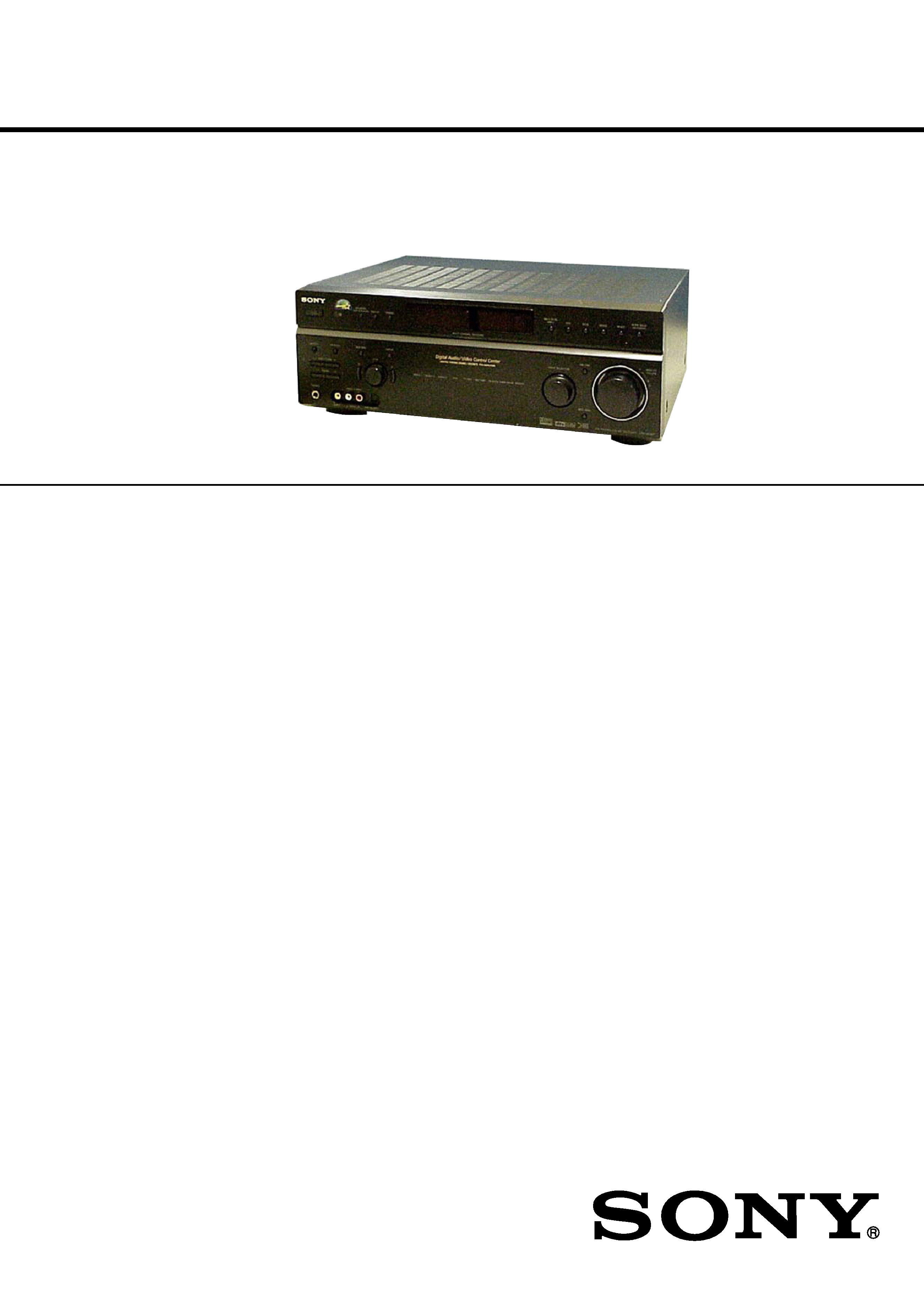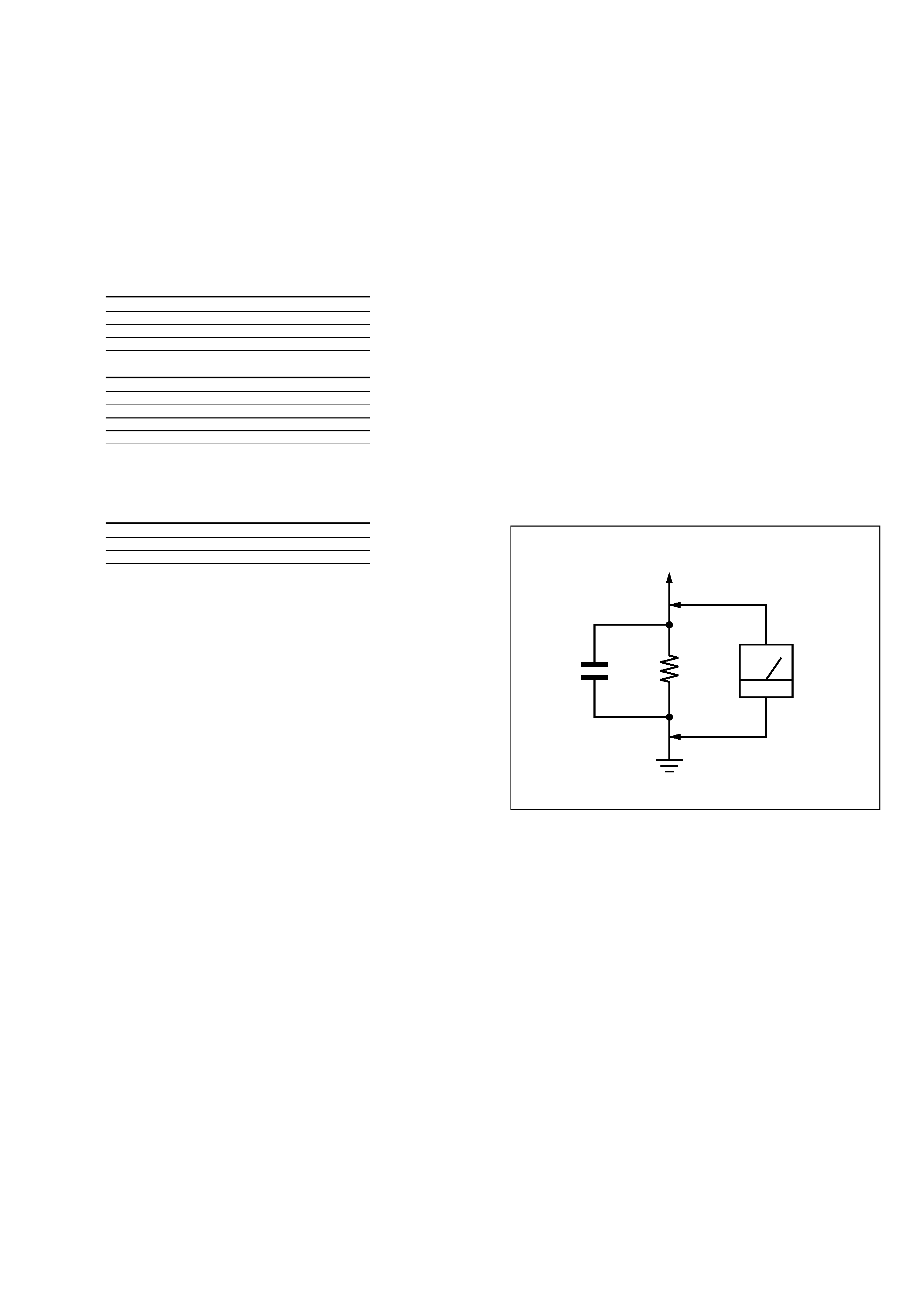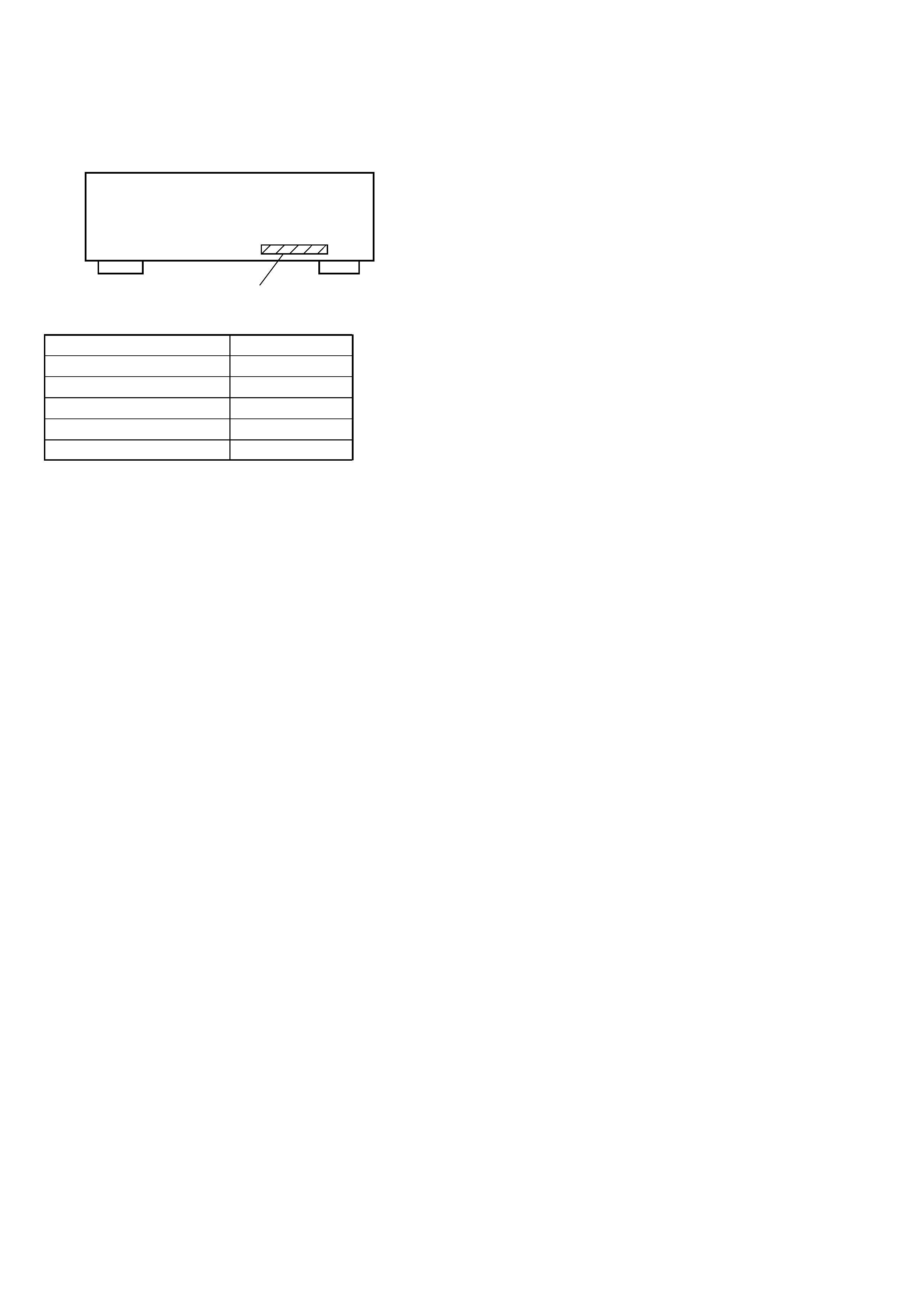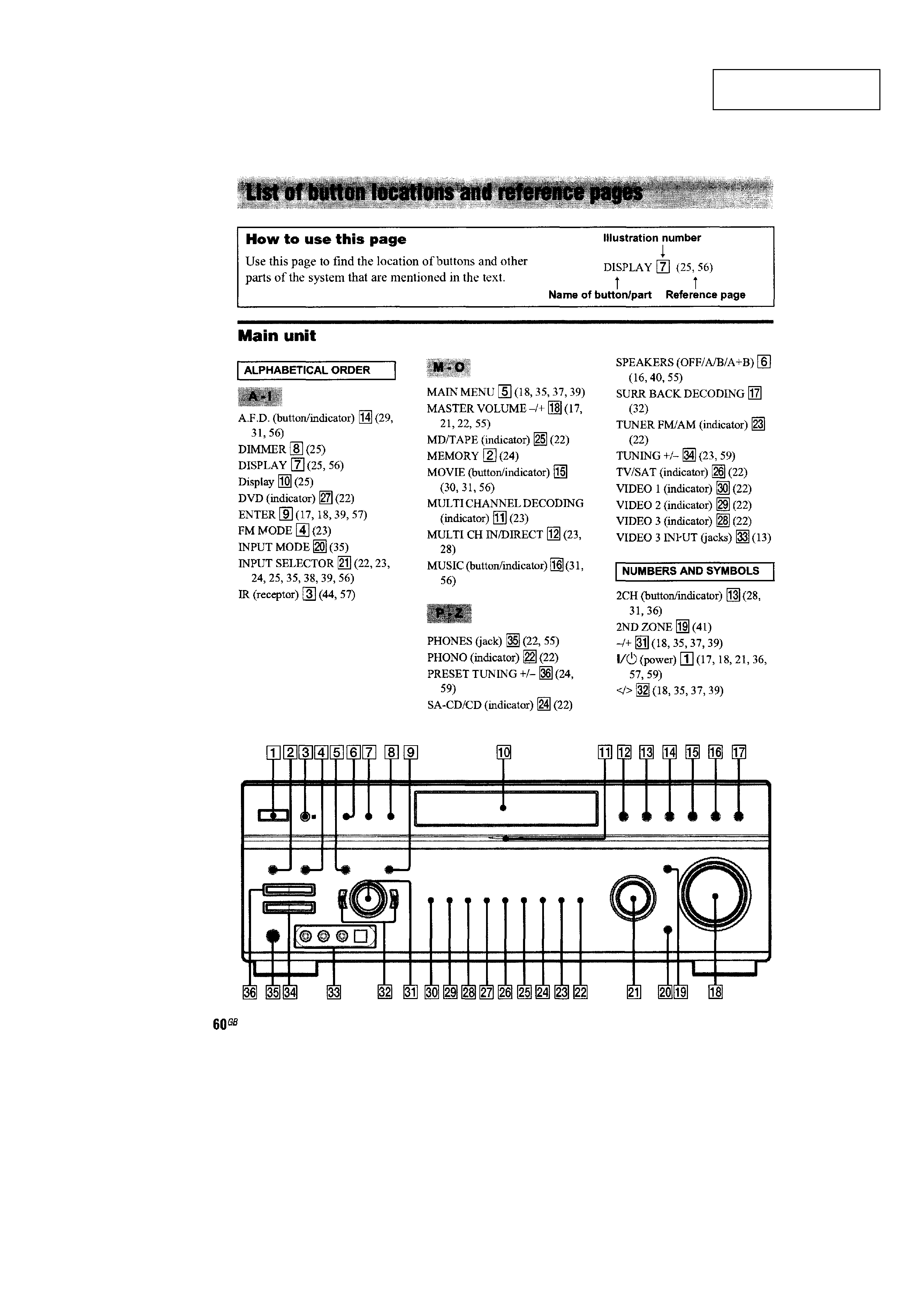
1
SERVICE MANUAL
US Model
Canadian Model
E Model
STR-DE897
FM STEREO/FM-AM RECEIVER
AUDIO POWER SPECIFICATIONS
POWER OUTPUT AND TOTAL HARMONIC
DISTORTION:
(Models of area code US only)
With 8 ohm loads, both channels driven, from
20 20,000 Hz; rated 100 watts per channel
minimum RMS power, with no more than
0.09 % total harmonic distortion from 250
milliwatts to rated output.
Amplifier section
Power Output
Models of area code US, CND
Rated Power Output at Stereo Mode
(8 ohms 20 Hz 20 kHz, THD 0.09 %)
100 W + 100 W 1)
Reference Power Output 1)
(8 ohms 20 Hz 20 kHz, THD 0.09 %)
FRONT 2) : 100 W/ch
CENTER 2) : 100 W
SURR 2) : 100 W/ch
SURR BACK 2) : 100 W/ch
(8 ohms 1 kHz, THD 0.7 %)
FRONT 2) : 110 W/ch
CENTER 2) : 110 W
SURR 2) : 110 W/ch
SURR BACK 2) : 110 W/ch
SPECIFICATIONS
Models of area code E2
Rated Power Output at Stereo Mode
(8 ohms 1 kHz, THD 0.7 %)
110 W + 110 W 1)
Reference Power Output 1)
(8 ohms 1 kHz, THD 10 %)
FRONT 2) : 130 W/ch
CENTER 2) : 130 W
SURR 2) : 130 W/ch
SURR BACK 2) : 130 W/ch
Models of area code AR
Rated Power Output at Stereo Mode
(8 ohms 1 kHz, THD 0.7 %)
110 W + 110 W 1)
100 W + 100 W 3)
Reference Power Output 1)
(8 ohms 1 kHz, THD 10 %)
FRONT 2) : 130 W/ch
CENTER 2) : 130 W
SURR 2) : 130 W/ch
SURR BACK 2) : 130 W/ch
Ver. 1.2 2005. 04
9-877-834-03
2005D04-1
© 2005. 04
Sony Corporation
Audio Group
Published by Sony Engineering Corporation
Manufactured under license from Dolby Laboratories.
"Dolby", "Pro Logic" and the double-D symbol are
trademarks of Dolby Laboratories.
"DTS", "DTS-ES", "Neo:6" and "DTS 96/24" are
trademarks of Digital Theater Systems, Inc.
Continued on next page
Photo: Black type

2
STR-DE897
Models of area code MY, SP
Rated Power Output at Stereo Mode
(8 ohms 1 kHz, THD 0.7 %)
90 W + 90 W 1)
Reference Power Output 1)
(8 ohms 1 kHz, THD 10 %)
FRONT 2) : 115 W/ch
CENTER 2) : 115 W
SURR 2) : 115 W/ch
SURR BACK 2) : 115 W/ch
1) Measured under the following conditions:
Area code
Power requirements
US, CND
120 V AC, 60 Hz
E2
240 V AC, 50 Hz
AR, MY, SP
230 V AC, 50 Hz
2) Depending on the sound field settings and the
source, there may be no sound output.
3) Measured under the following conditions:
Area code
Power requirements
AR
220 V AC, 50 Hz
Frequency response
PHONO
RIAA equalization curve
±0.5 dB
MULTI CH IN 1, 2,
10 Hz 70 kHz
SA-CD/CD, TV/SAT,
+0.5/2 dB (with sound
MD/TAPE, DVD,
field and equalizer
VIDEO 1, 2, 3
bypassed)
Inputs (Analog)
PHONO
Sensitivity: 8 mV
Impedance: 50 kiloohms
S/N 4) : 86 dB
(A, 8 mV 5) )
MULTI CH IN 1, 2,
Sensitivity: 500 mV
SA-CD/CD, TV/SAT,
Impedance: 50 kiloohms
MD/TAPE, DVD,
S/N 4) : 96 dB
VIDEO 1, 2, 3
(A, 500 mV 5) )
4) INPUT SHORT (with sound field and equalizer
bypassed).
5) Weighted network, input level.
Inputs (Digital)
DVD, SA-CD/CD
Sensitivity:
(Coaxial)
Impedance: 75 ohms
S/N: 100 dB
(A, 20 kHz LPF)
TV/SAT, SA-CD/CD,
Sensitivity:
MD/TAPE, VIDEO 3
Impedance:
(Optical)
S/N: 100 dB
(A, 20 kHz LPF)
Outputs (Analog)
MD/TAPE (OUT),
Voltage: 500 mV
VIDEO 1, 2
Impedance: 10 kiloohms
(AUDIO OUT)
SUB WOOFER
Voltage: 2 V
Impedance: 1 kiloohms
Outputs (Digital)
MD/TAPE (Optical)
Sensitivity:
Equalizer
Gain levels
±10 dB, 0.5 dB step
FM tuner section
Tuning range
87.5 108.0 MHz
Antenna
FM wire antenna
Antenna terminals
75 ohms, unbalanced
Intermediate frequency
10.7 MHz
Sensitivity
Mono:
18.3 dBf, 2.2 µV/75 ohms
Stereo:
38.3 dBf, 22.5 µV/75 ohms
Useable sensitivity
11.2 dBf, 1 µV/75 ohms
S/N
Mono:
76 dB
Stereo:
70 dB
Harmonic distortion at 1 kHz
Mono:
0.3%
Stereo:
0.5%
Separation
45 dB at 1 kHz
Frequency response
30 Hz 15 kHz,
+0.5/2 dB
Selectivity
60 dB at 400 kHz
AM tuner section
Tuning range
Models of area code US, CND
With 10-kHz tuning scale: 530 1,710 kHz 6)
With 9-kHz tuning scale: 531 1,710 kHz 6)
Models of area code E2
With 10-kHz tuning scale: 530 1,610 kHz 6)
With 9-kHz tuning scale: 531 1,602 kHz 6)
Models of area code AR
With 10-kHz tuning scale: 530 1,610 kHz
Models of area code MY, SP
With 9-kHz tuning scale: 531 1,602 kHz
Antenna
Loop antenna
Intermediate frequency
450 kHz
Usable sensitivity
50 dB/m (at 1,000 kHz or
999 kHz)
S/N
54 dB (at 50 mV/m)
Harmonic distortion
0.5 % (50 mV/m, 400 Hz)
Selectivity
At 9 kHz:
35 dB
At 10 kHz:
40 dB
6) You can change the AM tuning scale to 9 kHz or 10 kHz.
After tuning in any AM station, turn off the receiver. While
holding down PRESET TUNING + or TUNING +, press
?/1. All preset stations will be erased when you change
the tuning scale. To reset the scale to 10 kHz (or 9 kHz),
repeat the procedure.
Ver 1.1

3
STR-DE897
Video section
Inputs/Outputs
Video:
1 Vp-p, 75 ohms
S-video:
Y: 1 Vp-p, 75 ohms
C: 0.286 Vp-p, 75 ohms
COMPONENT VIDEO:
Y: 1 Vp-p, 75 ohms
PB/CB/B-Y: 0.7 Vp-p,
75 ohms
PR/CR/R-Y: 0.7 Vp-p,
75 ohms
80 MHz HD Pass Through
General
Power requirements
Area code
Power requirements
US, CND
120 V AC, 60 Hz
E2
120/220/240 V AC, 50/60 Hz
AR, MY, SP
220 230 V AC, 50/60 Hz
Power consumption
Area code
Power consumption
US, E2
300 W
CND
410 VA
AR
260 W
MY, SP
230 W
Power consumption (during standby mode)
0.3 W (when "POWER
SAVE" in the CUSTOMIZE
menu is set to "ON")
AC outlets
Area code
AC outlets
US, CND
2 switched, 120 W/1A MAX
E2 , MY, SP
1 switched, 100 W MAX
Dimensions (w/h/d) (Approx.)
430
× 157.5 × 371 mm
(16 7/8
× 6 2/8 × 14 5/8
inches) including
projecting parts and
controls
Mass (Approx.)
10.7 kg (23 lb 10 oz)
Supplied accessories
FM wire antenna (1)
AM loop antenna (1)
Remote commander RM-PG413 (1) (EXCEPT MY, SP)
Remote commander RM-PP413 (1) (MY, SP)
R6 (size-AA) batteries (2)
Design and specifications are subject to change
without notice.
·Abbreviation
CND : Canadian model
E2
: AC 120 V area in E model
AR
: Argentina model
MY : Malaysia model
SP
: Singapore model
SAFETY-RELATED COMPONENT WARNING!!
COMPONENTS IDENTIFIED BY MARK 0 OR DOTTED LINE
WITH MARK 0 ON THE SCHEMATIC DIAGRAMS AND IN
THE PARTS LIST ARE CRITICAL TO SAFE OPERATION.
REPLACE THESE COMPONENTS WITH SONY PARTS WHOSE
PART NUMBERS APPEAR AS SHOWN IN THIS MANUAL OR
IN SUPPLEMENTS PUBLISHED BY SONY.
ATTENTION AU COMPOSANT AYANT RAPPORT
À LA SÉCURITÉ!!
LES COMPOSANTS IDENTIFIÉS PAR UNE MARQUE 0 SUR LES
DIAGRAMMES SCHÉMATIQUES ET LA LISTE DES PIÈCES
SONT CRITIQUES POUR LA SÉCURITÉ DE FONCTIONNEMENT.
NE REMPLACER CES COMPOSANTS QUE PAR DES PIÈCES
SONY DONT LES NUMÉROS SONT DONNÉS DANS CE MANUEL
OU DANS LES SUPPLÉMENTS PUBLIÉS PAR SONY.
1.5 k
0.15 µF
AC
voltmeter
(0.75 V)
To Exposed Metal
Parts on Set
Earth Ground
SAFETY CHECK-OUT (US MODEL)
After correcting the original service problem, perform the follow-
ing safety check before releasing the set to the customer:
Check the antenna terminals, metal trim, "metallized" knobs, screws,
and all other exposed metal parts for AC leakage.
Check leakage as described below.
LEAKAGE TEST
The AC leakage from any exposed metal part to earth ground and
from all exposed metal parts to any exposed metal part having a
return to chassis, must not exceed 0.5 mA (500 microampers.).
Leakage current can be measured by any one of three methods.
1. A commercial leakage tester, such as the Simpson 229 or RCA
WT-540A. Follow the manufacturers' instructions to use these
instruments.
2. A battery-operated AC milliammeter. The Data Precision 245
digital multimeter is suitable for this job.
3. Measuring the voltage drop across a resistor by means of a
VOM or battery-operated AC voltmeter. The "limit" indica-
tion is 0.75 V, so analog meters must have an accurate low-
voltage scale. The Simpson 250 and Sanwa SH-63Trd are ex-
amples of a passive VOM that is suitable. Nearly all battery
operated digital multimeters that have a 2 V AC range are suit-
able. (See Fig. A)
Fig. A. Using an AC voltmeter to check AC leakage.
Ver 1.1

4
STR-DE897
TABLE OF CONTENTS
1. GENERAL
Main unit ................................................................................. 5
Remote button description ....................................................... 6
2. DISASSEMBLY
2-1. Case ..................................................................................... 7
2-2. Front Panel Section ............................................................. 8
2-3. Back Panel Section .............................................................. 8
2-4. Digital Board ....................................................................... 9
2-5. STBY Board ........................................................................ 9
2-6. Main Board ....................................................................... 10
3. TEST MODE ..................................................................... 11
4. DIAGRAMS
4-1. IC Pin Descriptions ........................................................... 12
4-2. Circuit Boards Location .................................................... 15
4-3. Block Diagram Tuner/Audio Section .......................... 16
4-4. Block Diagram Digital Section ................................... 17
4-5. Block Diagram Video Section ..................................... 18
4-6. Block Diagram Key/Display Section .......................... 19
4-7. Block Diagram
Up Convert Section (US, Canadian Model) ............... 20
4-8. Block Diagram Power Section .................................... 21
4-9. Printed Wiring Boards Main Section .......................... 23
4-10. Schematic Diagram Main Section (1/4) ...................... 24
4-11. Schematic Diagram Main Section (2/4) ...................... 25
4-12. Schematic Diagram Main Section (3/4) ...................... 26
4-13. Schematic Diagram Main Section (4/4) ...................... 27
4-14. Printed Wiring Board Digital Section (1/2) ................ 28
4-15. Printed Wiring Board Digital Section (2/2) ................ 29
4-16. Schematic Diagram Digital Section (1/3) ................... 30
4-17. Schematic Diagram Digital Section (2/3) ................... 31
4-18. Schematic Diagram Digital Section (3/3) ................... 32
4-19. Printed Wiring Board Audio Section ........................... 33
4-20. Schematic Diagram Audio Section ............................. 33
4-21. Printed Wiring Boards Video Section ......................... 34
4-22. Schematic Diagram Video Section .............................. 35
4-23. Printed Wiring Board
Up Convert Section (US, Canadian Model) ............... 36
4-24. Schematic Diagram
Up Convert Section (US, Canadian Model) ............... 36
4-25. Printed Wiring Board S-video Section ........................ 37
4-26. Schematic Diagram S-video Section ........................... 37
4-27. Printed Wiring Boards Panel Section (1/2) ................. 38
4-28. Schematic Diagram Panel Section (1/2) ..................... 39
4-29. Printed Wiring Boards Panel Section (2/2) ................. 40
4-30. Schematic Diagram Panel Section (2/2) ..................... 41
4-31. Printed Wiring Boards Power Section ......................... 42
4-32. Schematic Diagram Power Section ............................. 43
4-33. IC Block Diagrams ............................................................ 44
5. EXPLODED VIEWS
5-1. Case Section ...................................................................... 49
5-2. Front Panel Section ........................................................... 50
5-3. Back Panel Section ............................................................ 51
5-4. Chassis Section ................................................................. 52
6. ELECTRICAL PARTS LIST ........................................ 53
MODEL IDENTIFICATION
-- BACK PANEL --
Part No.
MODEL
PART No.
US
4-252-935-0s
E2
4-252-935-2s
AR
4-252-935-3s
CND
4-252-935-4s
SP, MY
4-252-935-7s
·Abbreviation
CND : Canadian model
E2
: AC 120 V area in E model
AR : Argentina model
MY : Malaysia model
SP
: Singapore model
Ver 1.1

5
STR-DE897
SECTION 1
GENERAL
This section is extracted
from instruction manual.
